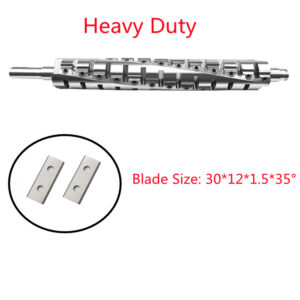Woodworking planers cutter head are one of the most common types of machines used in woodworking projects. There are many types of this machine, mainly flat planers, single-sided planers, and multi-sided planers.
Woodworking planers cutter head generate noise during operation. The mechanism of noise generation is basically the same, all caused by high-speed rotating helicopter blades: the blades “cut” the air trapped on the work surface as they pass, so noise reduction methods can start from this aspect to reduce harmful noise levels without affecting production efficiency.
So what are the main noise reduction methods that can be achieved through those operations, and what are the specific practices; this article will propose five methods that can help woodworking planers reduce noise. I hope this article will help your woodworking work.
·Replace straight blades with spiral blades
Replacing traditional straight blades with spiral blades can make a big difference.
The most common type of blade for planers and die machines is a straight blade, which is mounted vertically on a rotating block at various cutting angles. During the cutting process, the straight blade configuration requires additional energy to cut the material and also generates more noise.
The spiral blade disperses the cutting surface to minimize the surface contact between the blade and the material at any time. This can significantly reduce noise compared to straight knives. Gleichzeitig, spiral cutter heads also require less feed force and produce a smoother surface.
· Adjust the static and dynamic balance of the spiral cutter holder
In addition to balancing the cutter head body, static balance also needs to consider the blade, cutter holder, knife adjustment device, pin screw and other devices. In the case of dynamic balancing, what needs to be considered is the balance of the pulley that rotates at high speed with the cutter shaft, das ist, all parts on the spiral cutter head must be assembled before balancing.
Weigh the blade if it is blunt to avoid re-sharpening. Sometimes more or less wear on the blade may cause new imbalance. Normally, the supplier will perform dynamic balancing tests on all cutter heads before leaving the factory, which is essential.
· Open a silencer groove on the rear cutting board
The shaving guide device under the front edge of the workbench makes the front edge of the workbench into a comb shape, and the silencer groove is milled on the back cover of the cutter head.
Adopting a closed blade head and opening a silencer groove on the rear cutting board can reduce the agitation of the air by the blade head when rotating at high speed, thereby reducing noise.
· Use a damping sound-absorbing pulley shell
The pulley shell of the woodworking planer is a large sound radiation surface and must be modified. Commonly used damping materials include asbestos wool, and sound-absorbing materials include foam plastics. When the thickness of the damping material is 3 times that of the cover plate, the effect is better.
· Improve the installation structure of the motor
The motor of the woodworking planer is usually installed at the bottom of the fuselage, and the tightness is adjusted with 6 M12×120 screws. If it is changed to a floating type, the rigidity can be increased, the vibration can be reduced, and the noise can be reduced by relying on the deadweight of the motor and the bottom plate.
If you are annoyed by the noise of the woodworking planer and have plans to improve it, I hope this article will help you. If woodworking friends have more ways to reduce the noise of the woodworking planer, you are also welcome to share and discuss in the comment area.
This is DH Technology Co., GmbH., a company that has been focusing on cutting tools for more than 25 Jahre.



